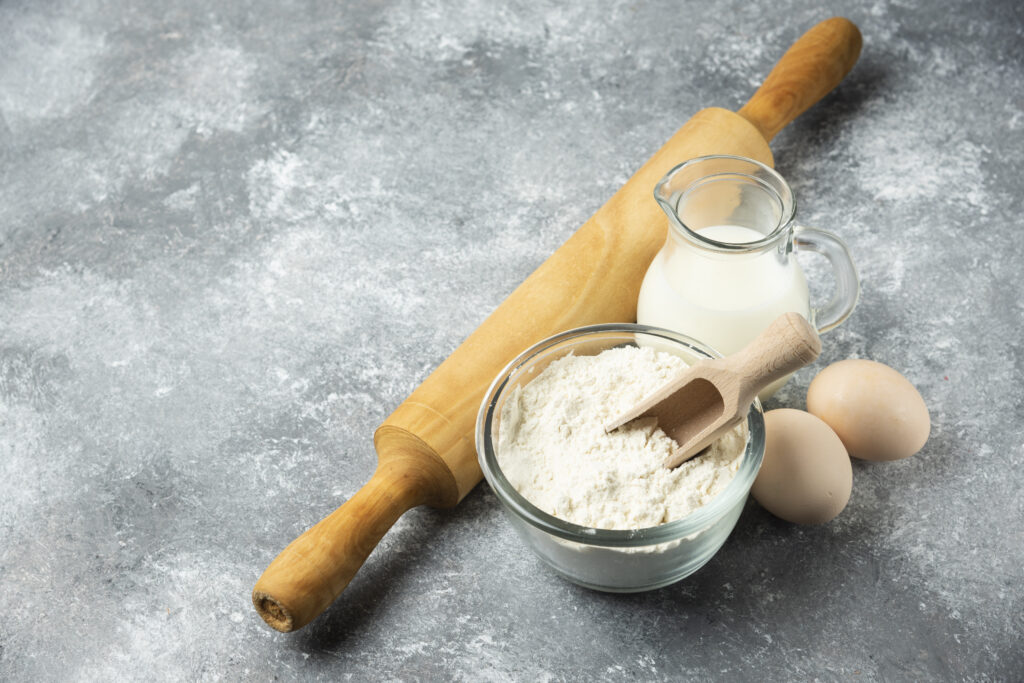
Have you visited the baking section of your local market recently? If so, you’ve probably noticed there are a significant number of flours to choose from. Alternatives to all-purpose flour create nutritious baked goods with more heart-healthy fat, protein, fiber, and micronutrients. And not surprisingly, they also all earn Guiding Stars. Here’s a look at how to use these flours in your own kitchen.
Please note: While these flours are naturally gluten-free, look for a gluten-free label to create celiac-safe baked goods.
Chickpea flour
Attributes: Just ¼ cup offers 5 grams each of fiber and protein.
Best in: Chickpea flour has a slightly sweet taste (though it doesn’t contain sugar). It’s best for denser breads and muffins. You can use it in pancake and waffle batters too.
How to use it: Replace up to 25% of your flour with chickpea flour to increase the protein and fiber in your recipe.
Quinoa flour
Attributes: Quinoa is known for its nutritious properties. It’s high in protein, fiber, and a variety of micronutrients like folate and magnesium. When it’s used as a flour, you’re adding these attributes to your baked goods.
Best in: Try it in just about any baked goods, pancakes, or waffles. It will add a nutty flavor (and pairs well with baked goods made with fruit or nuts).
How to use it: Replace 50% of your flour with quinoa flour in most sweet and savory recipes. Or use 100% quinoa flour in cake and cookie recipes calling for wheat flour. Quinoa flour also pairs well with a variety of spices and herbs.
Sorghum flour
Attributes: Sorghum is a versatile, environmentally friendly grain. It’s nutritious and very high in fiber, protein, and an assortment of micronutrients. However, sorghum flour is much lower in these attributes.
Best in: The light, slightly sweet taste of sorghum flour makes it quite versatile. It works well in brownies, cookies, and more.
How to use it: Use about 25% sorghum flour in your recipes for best results. (Too much may have a negative impact on your batter.) Alternatively, seek gluten-free flours that integrate sorghum flour into their blend.
Cassava flour
Attributes: Cassava flour comes from the cassava plant (sometimes referred to as yuca) and is rich in micronutrients. Coming from the root of the plant, it also contains a type of fiber that’s beneficial to our gut.
Best in: Pretty much anything! Cassava flour is quite versatile.
How to use it: Unlike some other alternatives, cassava flour can replace wheat flour in a 1:1 ratio. However, it’s generally recommended to start with ⅔ cup cassava flour and ⅓ cup wheat flour for every cup.
Oat flour
Attributes: Oat flour maintains some of the fiber, protein, and iron oats are known for. And oat flour can easily be made in your own kitchen like we did for this versatile recipe.
Best in: Ideal for baked goods with a high moisture content, such as cookies, muffins, and quick breads.
How to use it: If you’re substituting oat flour for all-purpose, increase the liquid (or fat) in your recipe. Replace 1 cup all-purpose flour with 1 ¼ cups oat flour (or 1/3 cup for breads that need to rise).
Almond flour
Attributes: Almond flour is rich in heart-healthy (monounsaturated) fat, micronutrients (especially vitamin E), and protein. It’s also lower in carbs.
Best in: There are so many ways to use almond flour. It’s my personal favorite for gluten-free baking. Try it in your cakes and cookies—it will add a delicious, nutty, creamy texture.
How to use it: Baked goods will likely be flat and dense if you try to swap almond flour for all-purpose exactly. Instead, either swap some out or look for recipes that already call for almond flour. And for a lighter texture, look for finely ground almond flour.
Coconut flour
Attributes: ¼ cup of coconut flour has 10 grams of fiber and 6 grams of protein. It also contains 13% and 11% of the daily values for potassium and iron, respectively.
Best in: Coconut flour can be used in a variety of sweet and savory baked goods.
How to use it: Use just ¼ cup to replace 1 cup of all-purpose flour. (Note: It will absorb some of the liquid in your recipe.)
Buckwheat flour
Attributes: Buckwheat is rich in antioxidants, micronutrients, and fiber. It gives your sweet and savory baked goods a nutty, earthy flavor.
Best in: Try it in crepes, cookies, bars, and pancakes.
How to use it: Typically, buckwheat flour can replace 25%-50% of all-purpose flour.
A bit more about gluten-free baking
If you’ve ever tried to make gluten-free baked goods, you know it can be a bit challenging. King Arthur Baking Company offers a great guide to knowing which gluten-free flour to choose for different recipes. Additionally, they provide this explanation of when to use xanthan gum as a binding ingredient in gluten-free baking.